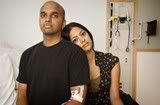 Over the summer, I wrote about Vinay Chakravarthy, a doctor of South Asian descent who had been recently diagnosed (at the age of 28 and fresh out of medical school) with leukemia and was in need of a bone marrow transplant. However, as Razib and others noted, the odds of him finding a match were quite slim (~1 in 20,000), given the small donor pool that was most genetically similar. Vinay's friends and families took his misfortune and turned it into something positive, organizing bone marrow drives in several states, and concentrating on getting additional minority donors to join the bone marrow registry.
Over the summer, I wrote about Vinay Chakravarthy, a doctor of South Asian descent who had been recently diagnosed (at the age of 28 and fresh out of medical school) with leukemia and was in need of a bone marrow transplant. However, as Razib and others noted, the odds of him finding a match were quite slim (~1 in 20,000), given the small donor pool that was most genetically similar. Vinay's friends and families took his misfortune and turned it into something positive, organizing bone marrow drives in several states, and concentrating on getting additional minority donors to join the bone marrow registry.
The campaign has been wildly successful. Targeting "youth-oriented" sites such as Facebook and YouTube for recruitment, Team Vinay has managed to add 24,000 South Asians as new bone marrow donors--increasing the pool of potential matches by 20% in just a few short months. And what of Vinay himself? More after the jump...
Vinay found a match, and received a bone marrow transplant on August 24th. The most recent post on his website shows him at home and recovering slowly. It's always nice to have a happy ending (though of course, Vinay's story is far from over), but doubly so because of the lingering impact Vinay's recruitment efforts will have on bone marrow registration, both within the South Asian community and beyond:
"Vinay's campaign was the most supercharged, organized, energetic people we've worked with. They utilized all the people-marketing, public relations, and online guerrilla tactics possible," said Regan Hall Reinerth, spokesman for the National Marrow Donor Program. Impressed with the campaign results, the registry is now creating a website to specifically recruit South Asian donors, Reinerth said.
The article also notes that drives like this helped to circumvent some cultural issues that may have somewhat impeded (or at least, not encouraged) donation in the past:
Vinay Lal, a professor of South Asian studies at UCLA, said that until recently, South Asian Americans might not have participated widely in broad philanthropic causes because the community's charitable traditions are usually more narrowly focused and tied to specific religious institutions.
South Asians have "only begun to have a larger sense of community," he said. To overcome such cultural tendencies, Chakravarthy's supporters decided to hop on the Internet.
On the "Help Vinay" website, video clips featuring legendary Indian actors as well as Chakravarthy's family tell of the merits of being a marrow donor. The site also provides information about how to launch donor drives, including how many tents and chairs would be needed to hold one on a college campus.
There's no reason this model has to be limited to the South Asian population; other groups certainly can borrow these online "guerrilla tactics" to stimulate interest in their own causes. As freshman Nehal Patel noted:
"If someone gives you a compelling enough story, it motivates anyone, even if you don't know them," he said.
I noted in my last post that "the National Marrow Donor Program estimates that 35,000 people could benefit from marrow transplants every year, but only a small number of those actually receive them." Perhaps some guerrilla tactics are needed in more populations in order to get people up and on the registry.
Image from http://www.mediafire.com/imgbnc.php/ad7120bf142fbc40c2e459d725f010554g…

I paid myself for the tests and am on the registry in South Africa.
Does anyone know if there are international databases on these?? I mean, I should be a closer genetic match to someone in the US.